#Townsend Rhodes
Text
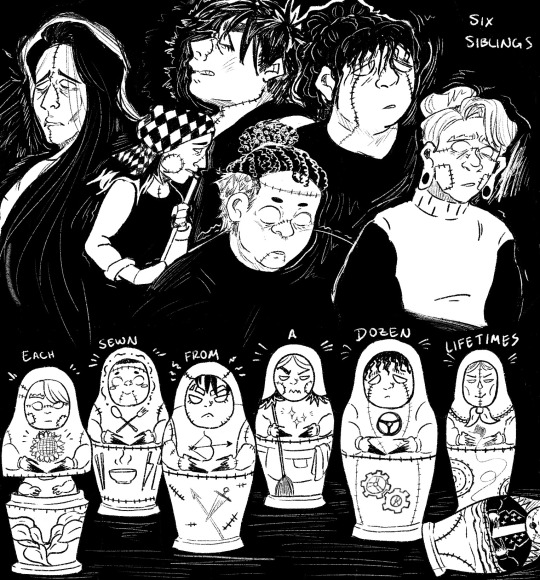

Ah yes tragic siblings my favorite
Excerpt from Hello From the Hallowoods Episode 140
I wanted to finish this before Season 4 started but I didn’t
#hello from the hallowoods#hfth#hfth season 3#leyland blooms#cookery potts#huntington waites#floris scrubbs#townsend rhodes#stitchery pins#diggory graves#hfth spoilers#hfth s3#the mendies
228 notes
·
View notes
Text
I think we as a fandom forget how unhinged the Mendies all are (especially Huntington):


(Cookery talking to Solomon)


Convinced this is Mendy-language for "You look like shit"
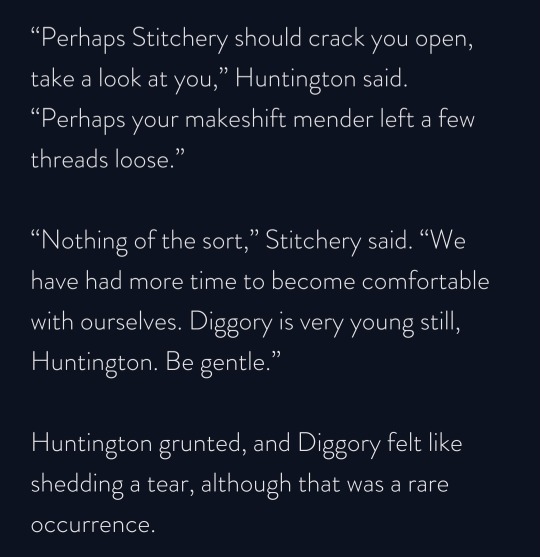


I'm never getting over Bern calling Stitchery "an evil advisor"
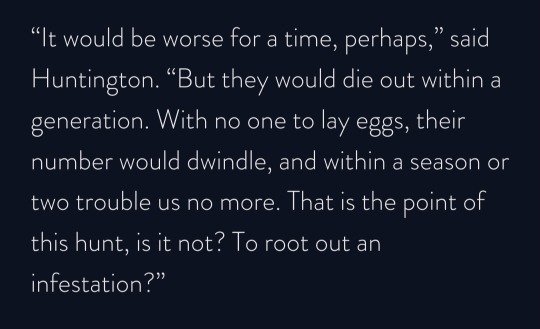
*Huntington casually suggests extinction*
#hfth#the mendies#diggory graves#leyland blooms#cookery potts#townsend rhodes#stitchery pins#huntington waites#floris scrubbs#they really are siblings#especially stitchery telling huntington off#wish there were more fics based around the mendies#maybe i should start writing fics
65 notes
·
View notes
Text
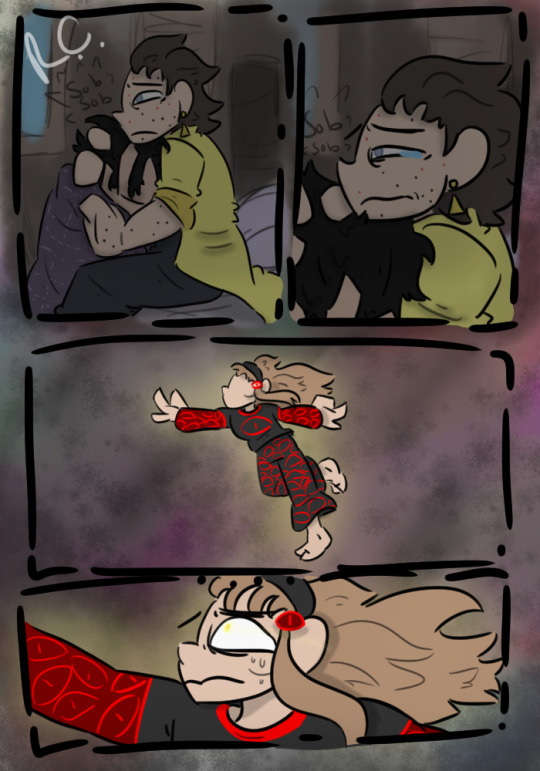


Scout post 2
(no i don't regret drawing a bunch of characters why do ya ask?)
#hello from the hallowoods#hfth#hfth s3#hfth spoilers#hfth 140#sacrifices#tw body horror#clementine maidstone#valerie maidstone#danielle o'hara#virgil kane#brooklyn williams#marco torres#violet keene#bern keene#leyland blooms#cookery potts#huntington waits#floris scrubbs#townsend rhodes#stitchery pins#buck silver#harrow blackletter#victoria tepiani#arnold eggers#i was dreading all the character tags#so many mendies#so many silly names#hope you enjoyed#ye!
25 notes
·
View notes
Text
#hello from the hallowoods#hello from the hallowoods polls#hfth#hfth polls#Cookery Potts#Diggory Graves#Huntington Waits#Leyland Blooms#Stitchery Pins#Townsend Rhodes#Mendies
17 notes
·
View notes
Text
In part, Townsend and his displaced friends wanted to do something to reclaim their sense of agency — to assert that spaces like the mall could belong just as much to them as to the developers. In order to do this, they would need to find a space in the mall where they could hide themselves away — an area that was not a store, nor a parking lot, nor a storage area. What they needed was that accidental room that Townsend had spotted years ago.

The mall’s developers had inadvertently provided a refuge from the world that they were busy developing. Inside, there were no plans for supermarkets or parking lots or retail spaces. It was a perch from which Townsend and his friends could observe the world, without being in it or being threatened by new developments.

One of my favourite real world stories, look up the art collective Tummerkind if after this article you want more of this story from their website
260 notes
·
View notes
Text
Round 1!
The TCAT, Tompkins County, NY, USA vs Seattle Center Monorail, Seattle, WA, USA
M1 (or Millennium Underground Railway, but also known as "the small underground" by locals), Budapest, Hungary vs Grande Recife, Recife, Brazil
London Underground, Greater London, England vs Rotterdam Metro, Rotterdam, Netherlands
Beamish Tramway, Beamish Museum, Beamish, England vs Catbus/Nekobus, Sayama Hills, Saitama Prefecture, Japan (My Neighbor Totoro)
The New York City Subway system, New York City, NY, USA vs Corviknight Flying Taxi, Galar (Pokémon Sword and Shield)
Buenos Aires Underground (Subte), Autonomous City of Buenos Aires, Argentina vs Monte Toboggan, Funchal, Madeira, Portugal
The Stargate Network, throughout the Milky Way and Andromeda Galaxies (the Stargate franchise) vs the Deepsea Metro, Inkopolis Bay (Splatoon)
CAT, Perth, Western Australia vs SkyTrain, Vancouver, British Columbia, Canada
Brolly Rail, Nevermoor (Nevermoor by Jessica Townsend) vs Métro Ligne 4, Paris, France
Tyne and Wear Metro, Tyne and Wear, United Kingdom vs the REM, Montreal, Quebec, Canada (upcoming)
Jeepney, the Philippines vs Sea Train, Water 7, connecting it with St. Poplar, San Faldo, and Pucci, as well as the Judicial Island Enies Lobby (One Piece)
The MTR, Hong Kong, PRC vs the Omnibus, New York, NY, USA (1832)
SeaBus, Vancouver, British Columbia, Canada vs Wuppertaler Schwebebahn, Wuppertal, Germany
Ice Highway, the Nether Roof (Minecraft) vs Battle Subway, Unova (Pokémon Black and White)
WY Metro, West Yorkshire, United Kingdom vs Tunnelbana, Stockholm, Sweden
MRT (Moda Raya Terpadu/Mass Rapid Transit), Jakarta, Indonesia vs An Luas, Dublin, Ireland
RIPTA (Rhode Island public transit authority) (it’s buses), Rhode Island, USA vs Bakerloo Line, London Underground, London, England
Mount Vesuvius Funicular Railway, Mount Vesuvius, Italy (opened in 1880, destroyed by volcanic eruption in 1944) vs AquaBus, Vancouver, British Columbia, Canada
Yarra Trams, Melbourne, Victoria, Australia vs SEPTA (southeast pennsylvania transportation authority), Pennsylvania, United States
Cable Cars, San Francisco, California, United States vs MAX Light Rail system, Portland, Oregon, United States
Amtrak, United States vs Fenelon Place Elevator, Dubuque, Iowa, United States
Ninky Nonk, Night Garden (In The Night Garden) vs Prague Metro, Prague, Czech Republic
Polar Bear Express, between Cochrane and Moosonee, Ontario, Canada vs the Crosstown Express, Robot City (Robots (2005))
Massachusetts Bay Transportation Authority (the T), Greater Boston, Massachusetts, United States vs Worcester Regional Transit Authority, Worcester County, Massachusetts, United States
Kakola Funicular, Turku, Finland vs Angkutan Kota (Angkot), Indonesia
Galaxy Railways, the Milky Way (The Galaxy Railways (銀河鉄道物語, Ginga Tetsudō Monogatari)) vs The Ride, Ann Arbor, Michigan, United States
MST Trolley, Monterey, California, United States vs People Mover, Magic Kingdom, Walt Disney World, Florida, United States
Public Transit Victoria, Victoria, Australia vs Carmelit, Haifa, Israel
The L, Chicago, Illinois, United States vs Leadhills and Wanlockhead Railway, South Lanarkshire, Scotland
Personal Rapid Transit (PRT), Morgantown, West Virginia vs Helsingin seudun liikenne/Helsingforsregionens trafik/Helsinki Regional Transport, Helsinki, Finland
Gondolas, Venice, Italy vs the Trolley from the Trolley Problem (Philippa Foot came up with it originally, but in media it was also presented in "the good place")
Zahnradbahn Stuttgart (die Zacke), Stuttgart (Marienplatz to Degerloch), Baden-Württemberg, Germany vs Detroit People Mover, Detroit, Michigan, United States
Warp Pipes (Super Mario Bros.) vs SCMaglev, Yamanashi, Japan
Transport Canberra Bus Network, Canberra, Australia vs Stagways, Hallownest (Hollow Knight)
Roosevelt Island Tram, Roosevelt Island, New York, NY, United States vs NJ Transit (Northeast Corridor), New Jersey, United States
Sunrail, Orlando, Florida, United States vs Bay Area Rapid Transit, Bay Area, California, United States
Purple Route (Charm City Circulator), Baltimore, Maryland, United States vs Alderney Ferry (Halifax Transit), Halifax, Nova Scotia, Canada
Millennium Line, Vancouver, British Columbia, Canada vs MARTA, Atlanta, Georgia, United States
Dual Mode Vehicle (DMV), Asa Coast Railway, Shikoku, Japan vs Lynton and Lynmouth Cliff Railway, Lynmouth, England, UK
Hovercraft, Portsmouth - Ryde, UK vs Funiculars, the Questionable Area (Psychonauts 2)
WildNorWester, Sodor (The Railway Series) vs Shinkansen, Japan
Métro de Paris, Paris, France vs Metro do Porto, Porto, Portugal
Deutsche Bahn, Germany vs UC Davis Unitrans Bus System, Davis, California
Vaporetti, Venice, Italy vs Harbour Bus, Copenhagen, Denmark
24 notes
·
View notes
Photo


Subject: Townsend Rhodes
Art: Anna @cobalt-knave
Writing: Anna @cobalt-knave
[ID: A page titled ‘Townsend Rhodes’ with two illustrations of the Hello from the Hallowoods character. Townsend is a strongly-built, tall humanlike creature with stitched patchwork skin of several shades and short, natural black hair. In the first drawing they are wearing a tuxedo and are leaning against a tall steel beam. They hold a construction hat under one arm. This drawing is labeled, “7 feet” with a note, “They were surprised when I asked to draw them and posed with a piece of scrap metal.” The second, smaller illustration shows them examining a car engine while wearing a flannel. This drawing has a note, “They were wearing their tux to work on Irene’s car, so I loaned them a flannel.”
The second page is written in blocky, all-caps handwriting, titled ‘Townsend Rhodes’ followed by the below text:
Name: Townsend Rhodes
Dangerous? Yes
Sentience? Full sentience-- can be reasoned with.
Encounter location: Irene Mend’s house
Description: Approx. 7 feet tall, broad shouldered. Long, sharp hands with black at the ends of the fingers. Patchwork face and skin. The shape and personality of a refrigerator, as Bern put it. Quiet but polite and glad to be included.
Abilities: Doing whatever butlers do, handy with tools and cars, fixing things up (mechanically). (A red note adds, “Fighting awful old men and defending the Scoutpost.”)
Connections: (”Irene Mend, creator, employer” and “Solomon Reed, employer” is crossed out before it continues.) Mendies, Stitchery, Cookery, Huntington, Leyland, and Floris. (A note in red adds, “and Diggory, Scoutpost.” /end ID]
35 notes
·
View notes
Text
part something of research for @thereallvrb0y
I'm so productive today so here we go. Today, we got Ben Tallmadge, James McHenry, John and Abigail Adams. Love you, Richie
@thereallvrb0y
Oh, also, for my sources, I really just used Mount Vernon and the White House website because I am a capitalist piece of shit. (the white house has the best timeline, Mount Vernon has more specifics)
Benjamin Tallmadge
Benjamin Tallmadge was born on February 25, 1754 in Setauket, Long Island *insert Turn theme* as the second of five sons to Reverend Benjamin Tallmadge and Susannah Tallmadge. He was educated in the classics by his father, who didn't send him to Yale until 1769.
"President Dagge[t, at that University], on a visit to [his] father, examined and admitted [Tallboy] as qualified to enter college, when [he] was twelve or thirteen years old."
Tallmadge developed a "close friendship" with Nathan Hale as a student at Yale. I'll let someone more eloquent in Halemadge mythology tackle that information, but to me they seem kinda sus but slay.
He completed his studies in 1773 and took up a teaching post at a school in Wethersfield, Connecticut. However, after the disaster that was 1775, Tallmadge began seriously considering joining the Army. He was offered the position of lieutenant in one of the six month regiments in Connecticut by Captain Chester of Wethersfield in 1776. He first saw action in the Battle of Long Island in August 1776, which was a British victory. Meanwhile, his older brother, William, was taken prisoner at Long Island and "literally starved to death in one of [the British] prisons."
But all that bad stuff is okay because in December of that year, he was appointed to a captain in Colonel Elisha Sheldon's 2d Regiment of Light Dragoons, then rose to the rank of major in April 1777. They grow up so fast. Tallmadge was also present at Brandywine and Germantown, which would be slay queen pussy boss, if both those battles weren't losses lol.
In 1778, Tallmadge was appointed director of military intelligence by Washington, with a focus on getting information from New York City, so "[he] opened a private correspondence with some persons in New York (for Gen. Washington) which lasted through the war." This was, you guessed it, Abraham Woodhull, Caleb Brewster, Anna Strong (allegedly!), Robert Townsend, and Austin Roe (we don't know who tf that is).
Those people formed the Culper Spy Ring, named after the nickname given to Woodhull, "Samuel Culper." Tallmadge was given a similar nickname, "John Bolton".
A system was created for the spies in which numbers were substituted for common words, names, and places. A key was provided to Washington, Woodhull, and Townsend. Washington also provided them with invisible ink because apparently he's Dumbledore. A message would be written with it, sometimes on the back of a normal letter, for the recipient to treat the paper with a reagent to reveal the message. This, apparently, saw significant use.
"I have not any of the Ink, but I will endeavor to provide some of it as soon as possible," -Washington to Tallmadge on April 30, 1779
The Spy Ring prevented a British fleet from sailing for Rhode Island in July 1780. Woodhull passed the intelligence of the fleet to Tallmadge, who allerted Washington. A fake plan of attacking New York was made, which made the British recall their ships, and allowed Lafayette and Rochambeau to land 6,000 troops at Newport.
Tallmadge also played a significant role in the apprehension of John Andre. If you want the whole story of John Andre's arrest and Benedict Arnold's flee from West Point, I have that shit memorized and I love talking about it so send me an ask bc I don't feel like typing all that shit out rn lol.
After the war, Tallmadge returned to civilian life with his wife, Mary Floyd Tallmadge, and their seven children in Connecticut. He entered into several business and financial ventures, for example serving as president of the Phoenix Bank and joined the Ohio Company to purchase and resell land in the west.
During Washington's first presidential term, Tallmadge was given the position of postmaster for Litchfield, Connecticut. He was elected to Congress in 1800 as a Federalist (here in my notes I wrote "freaks who fuck together federal together" and I'm not sure why, but there you go) and remained in the House until 1817. He died at 81 in 1835.
James McHenry
James McHenry was born on November 16, 1753 in County Antrim, Ireland. He was classically educated in Dublin before immigrating to Philadelphia in 1771. He returned to Philadelphia from a term at Newark Academy in Delaware to study medicine under Dr. Benjamin Rush in the years leading up to the Revolutionary War.
He put his medical training to good use in the "American Continental Hospital" (idk why that's in quotes but I figured it's important) near Boston in the Autumn of 1775. He followed the Army to New York and was appointed surgeon for the 5th Pennsylvania Regiment on August 10, 1776. He was captured less than three months later with over 2,800 soldiers at the fall of Fort Washington on November 16, 1776. McHenry actively treated wounded comrades during captivity and informed Washington of the condition of prisoners of war in New York. He was exchanged in March 1778.
McHenry returned to his duty as a senior surgeon at Valley Forge. He accepted Washington's invitation to join his staff as an assistant secretary without a rank. He assisted in the duties of an aide-de-camp, and became particular friends with Alexander Hamilton, which is a job all within itself. He formed the opinion that Washington "is a singular exhibition of Human Excellence."
He proved himself "worthy to wield the sword as the pen" at Monmouth on June 28, 1778. He transferred to Lafayette's staff in August 1780 as an aide-de-camp and was given the rank of Major on October 30, 1780. McHenry "tempered the young Frenchman's ardor" during the 1781 Virginia campaign. He fought at the Battle of Green Spring and at Yorktown.
Oh, also, he was the only one on Hamilton's side at his wedding. Like literally everyone else there was in the Schuyler family or were family friends. Isn't that depressing. Anyway.
In December 1781, McHenry resigned military commission to sit in the Maryland senate. He began a correspondence with Washington in order to keep him aware of the political state of affairs that would continue for fourteen years. He held a number of local, state, and national government positions, including being a Maryland representative to the Constitutional Convention, where he reluctantly signed the document and voted for ratification.
Washington offered him the position of Secretary of War in early 1796 after three others declined. He remained in the cabinet of John Adams. During the Quasi war, in 1798, Washington expressed disappointment in Mchenry during the initial months of preparation for war. Despite this, he proved to be a capable Secretary, despite dealing with fucking John fucking Adams and "two domineering generals" aka Hamilton and Washington.
Adams forced McHenry's resignation in May of 1800 because he was loyal to Hamilton, and McHenry retired to his estate near Baltimore before his passing on May 3, 1816.
John Adams
John fucking Adams was born in the Massachusetts Bay Colony in 1735. His father was from Braintree, Massachusetts and was a farmer and a cobbler. Adams was educated at Harvard in 1751 and then decided to be a lawyer.
He married Abigail Smith in 1764. She was the daughter of a Weymouth, Congregationalist minister and granddaughter of pre-revolutionary era politician, John Quincy. They ended up having six kids and managing a farm together.
During the war, Adams served as a delegate to the First and Second Continental Congresses where he led the movement for Independence. He met George Washington for the first time in 1774. They dined together several times, and he respected Washington greatly. In 1775, he pushed Congress for him to be Commander in Chief of the Continental Army.
"This Appointment will have a great Effect, in cementing and securing the Union of these Colonies." -John Adams
Adams served in France and Holland in diplomatic roles during the war and helped negotiate the Treaty of Paris. However, he wasn't really a good diplomat. Everyone thought he was blunt, annoying, impatient, hypersensitive to criticism, and a fucking asshole. He would also convince himself that everyone else was evil and out to get him in some way. The most outrageous example of this, in my opinion, was the one time he accused the Marquis de Lafayette of attempting to colonize America... I'll let that sink in for a moment. Marquis de I'm-fucking-obsessed-with-America Lafayette. Mf literally had an America themed house and Adams thought "yep. he's plotting the downfall of this country." So that was fucking stupid.
Tl;dr Adams isn't as great as mainstream media thinks he is.
Adams also served as minister to the Court of St. James's from 1785-1788 but that was irrelevant apparently because I have no info on it lol.
Adams wanted to return when he got back to America but instead had to serve as Vice President and I don't feel bad for him. He didn't like being Vice President though, and I still don't feel bad for him.
"My country has in its wisdom contrived for me the most insignificant office that ever the invention of man contrived or his imagination conceived." -John Adams to Abigail Adams
He was a one term president after that and geez was that one term a mess. There was a war between France and Britain going on because the French are continually fucking up international affairs at this time, and that caused complication in American shipping and domestic affairs. Why domestic affairs, you ask? Take one guess. You're right, it's Hamilton.
Specifically Hamilton and Jefferson. Because of fucking course. The Federalist (Hamilton and Adams' party) wanted to support Britain because the French were too liberal, and the Democratic Republicans (Jefferson, Madison and Monroe's party/ies, it's complicated) wanted to support France because they were allies to the US once blah blah blah they were just liberal.
However, this all was different when um. France kind of. Fucked everything up. Again.
So basically Adams sent three commissioners to France to try to get them to stop fucking up everything so the US could mind their business. However, in the spring of 98, a little birdie tells Adams that French Foreign Minister Talleyrand (a fashion icon let me tell you /j) and the French Directory refused to negotiate unless the US gave them money.
Adams, a Federalist, was like FUCK THAT and snitched to COngress who was also like fuck that, and the Senate printed the correspondence, which only referred to the French commissioners or whatever they were as "X, Y, and Z" *roll credits*
The nation had "the X. Y. Z. fever" in the words of Tommy J which increased the popularity of the Federalist party because they realized the French were fucking everything up, and people even liked Adams for a little while.
So this caused some problems later, but I'll get to that in a sec. When the debate of France vs Britain was still largely 50/50, Adams approved this little thing you might have heard of called the Alien and Sedition Acts. These were acts made to "frighten foreign agents out of the country and stifle the attacks of Republican editors." To translate out of propaganda speak, Adams was trying to limit the rights of immigrants and stop people from printing negative things about him. So you know. Infringing on Constitutional Rights. (oh, btw, Hamilton agreed with these, which is why people say he was anti-immigrant)
Anyway back to the XYZ affair kind of. Basically, because of those proceedings, the US was like "...well we're fucked." And they were, because France started fighting America on the sea. And at this point in history, America was. detrimentally fucked when it came to anything military.
American shipping was basically defenseless since they disowned Daddy Britain who had big guns and big money, both of which were used to protect shipping. For example, (this comes up later with Jefferson), the Barbary states in North Africa had pirates that would attack European merchant vessels to steal their merchandise as well as the people on board to enslave. The European superpowers (Britain, Spain, France, etc.) would large sums of money for the Barbarian governments to keep their pirates from attacking their shipping. America didn't have that kind of money. And because they didn't have that kind of money to pay bribes, they didn't have that kind of money to buy guns. or ships. or gunpowder. or food. or like anything you need to run a navy.
So France was basically decimating American merchant ships. But they chilled out by 1800 because shit was going down. The Federalists called it a war since Daddy Hamilton was angry, but war was never officially declared, so we call it what the Democratic Republicans called it, the Quasi War.
Long negotiations ended the Quasi War and I don't care. However, someone special was a little bit kind of extremely PISSED that Adams sent a peace mission to France. Take one guess- you know what I'm not even going to let you finish, it's Hamilton.
By the time of the election of 1800, Republicans had their shit together. They knew Jefferson was the most obvious choice for president, with Burr being the kind of underdog that still had potential, however the Federalists were fucked, since the party was already dying. Now you're thinking, but wait, I thought Adams was Federalist. We'll not anymore because the sluttiness in the room is about to get ASTRONOMICAL.
Hamilton and Adams were on each other's shit list since the Revolutionary War. Hamilton hated Adams because Adams was in the Continental Congress and ignored how the army was struggling in order to make a point, and Adams hated Hamilton because Hamilton made him wake up at 3 am once (evacuation of Philadelphia).
Hamilton's political influence was so great, not because he was widely respected (he wasn't) but because he had people in nearly every position that he could influence to vote in the direction that benefited him most. It didn't always work, but it worked in Adams' case.
This was also another reason Hamilton didn't like Adams because, despite being in the same party as him, Adams was too stubborn to be manipulated by Hamilton. Also, when they were both in the cabinet, Adams was mostly, if not entirely, outcast from the proceedings, mainly because of how Hamilton and Jefferson overshadowed the other cabinet members with their big personalities, big opinions, and intense rivalry. To compound this even further, Hamilton held both second and first in command positions (the latter after Washington retired [again]). So for basically an entire decade, Hamilton unofficially outranked Adams, even though Adams held the more important position.
Their rivalry wasn't personal like Hamilton and Madison/Monroe, nor was it like Hamilton and Jefferson's rivalries where they were basically the antithesis of one another. It was really just political, but because they both expected the other to agree, being in the same party, and also because they were both so hypersensitive to criticism, it became very personal in their eyes.
Hamilton wanted Adams gone. And he handled this quite differently from how Jefferson handled it, even though they both wanted Adams out of the running.
Jefferson was basically the master of eliminating his political enemies from the competition. He, like many other statesmen of the time, including Hamilton, owned publishing companies where he would commission writers to publish slander against his political enemies in order to worsen public opinion of them, therefore losing them the majority of popular vote, and by extension, the electoral vote. This was the smart way to go about things, because it was anonymous, there was no risk of damage to Jefferson's public image most of the time. Emphasis on most of the time, because the newspaper wars of the earlier 1790s weren't as anonymous but whatever.
While Hamilton did utilize this strategy, when it was a case like Adams where he needed to deal the most about of damage as fast as possible, he needed to use more than one strategy at once. So in conjunction with the above, he also spread rumors, like he did with Burr at this exact same time, he made a direct publication(s). I put that s there because I haven't gotten to look into this era of Hamilton's life in excessive detail, so I don't know all the facts, but I do know how Hamilton works.
Essentially, Hamilton struck Adams' reputation on three fronts: word on the street, pamphlets circulating, and newspaper articles. Adding Jefferson's efforts, along with Hamilton's influence among the electoral voters, Adams was cast out of the running fairly quickly.
Adams gave up on politics after that, and retired to his farm in Quincy, and rebuilt his relationship with Jefferson, which had died sometime during the Washington administration, and they remained friends until July 4, 1826, when they both died.
"Thomas Jefferson survives" -John Adams' last words, not knowing Jefferson had died a few hours earlier. Dumbass.
Abigail Adams
Abigail Smith was born in 1744 at Weymouth, Massachusetts. She was descended from the Quincys on her mother's side. Every colony had Those Families that were pretty much their since the founding and made up the elite of that colony. New York had the Schuylers, Van Rensselaers, and Livingstons, Virginia had the Jeffersons, the Washingtons, and the other one, South Carolina had the Ramsays and the Pickneys, and Massachusetts had the Quincys and the Adamses.
Abigail lacked formal education, like most other women, but was known for her keen intelligence that she gained from reading whatever she could. This love of reading created a bond between her and John Adams, and they got married in 1764 when she was 19.
They lived together in John's farm at Braintree or in Boston when he had to do lawyer things. She had three sons and two daughters in ten years (ouch) and looked after the family and their home when John was running around the globe getting fired from every job he had.
"Alas! How many snow banks divide thee and me..." -Abigail Adams to John Adams in December 1773
They were apart for most of their relationship, and I think they're one of the best examples of the 18th century, mid-upper class relationship between husband and wife. In the American culture of this time, the wife was expected to remain home and raise the children, while also being involved in local politics and diplomacy to maintain the family name, while the husband was expected to have a similar role in state/national affairs. This is why you often see, in the upper class, women having prominent roles in their family and community.
Abigail joined John in Paris in 1784. Then, after 1785, she had to define and fill the role of wife of the first United States Minister to Great Britain, and she absolutely slayed. Then, they returned to Massachusetts in 1788.
Abigail had much a much more defined political ideology than other women at their time, even if they were equally involved in politics, because of how boldly she informed her husband, as well as the Massachusetts Colony General Court in 1775, of her beliefs. She was a humanitarian and an activist, with an unbiased opinion of the United States. She advocated for gender equality in public education and the need to pay attention to how women were affected by current events. When she was informed that the Declaration of Independence was to be written, she reminded her husband to, "Remember the Ladies..."
She also wrote a will that left the majority of her possessions to her female family members, which was surprising since her belongings would technically belong to her husband. As if he could argue with her. She was smarter than him.
Although Adams rarely listened to his wife, her opinions influenced him heavily. She had so much influence over him that she was nicknamed "Mrs. President" which I think is iconic.
She also believed in the necessity of emancipation, and firmly believed in independence, saying, "Let us separate, they are unworthy to be our Brethren. Let us renounce them..."
As the wife of the Vice President, she became good friends with Martha Washington, helping her with official entertaining, since she had experience in foreign courts. However, she became sick frequently after 1791, so she was in Massachusetts most of the time.
Funny story about when she met George Washington, she kind of didn't like him because he had slaves and was a member of the Virginia planter elite. But, after meeting him, she was "struck with General Washington" and said that he was marked by "Dignity with ease... the Gentleman and Soldier look agreeably blended in him."
When Adams became president, she continued a formal pattern of entertaining, even if the capital was kind of... not there. She fucking hated it.
She retired with her husband in 1801, and lived a happy life until 1818 when she died. She is buried beside her husband in United First Parish Church.
Okay geez that was a lot, I did this all in one day FHSKJHSKLJH (not the tallmadge and mchenry notes, i did those a while back, hence why i can't decipher "freaks who fuck together federal together). my wrist hurts so im going to go play minecraft and probably read fanfiction since ive got Hamilton on the brain (if you couldn't tell). hope this helps. love ya!!!!
#history#amrev#amrev history#american revolution#american history#benjamin tallmadge#james mchenry#john adams#abigail adams#alexander hamilton#hamilton#historical hamilton#thomas jefferson#if you can't tell i don't like adams#and im sure there are some positive things out there about him#i just cannot conjure those words myself#election of 1800#i had a really bad american history teacher in 7th grade so now whenever i have to talk or think about the xyz affair or the quasi war#part of me dies#but man am i glad to be done with this#also i think the schedule of me working on history on saturdays works pretty well because its easy work but still productive#im on a roll guys don't let me get off track#jk you're not responsible for me#but if i don't post for like months yell at me#be mean its okay#also ignore any typos you can't pay me to proofread my tumblr posts#i already cross referenced what more do you want from me#okay i'll shut up now#do it for richie 💪
24 notes
·
View notes
Text

The Important Lieutenant Colonel Caleb Gardner Chippendale Block-and-Shell-Carved
and Figured Mahogany Block-Front Chest of Drawers
Attributed to John Townsend (1733-1809)
Newport, Rhode Island
Circa 1788
Sotheby’s
3 notes
·
View notes
Text
"Secret Mall Apartment" Is A Hit @ SXSW 2024

Jeremy Workman returns to SXSW this year with “Secret Mall Apartment.” Eight individuals found a way to convert unused space within the Providence Place Mall in Rhode Island. They used it as a clubhouse and as a protest against gentrification. They were successful from 2003 to 2007 before being discovered. The film is a hoot! It was a big crowd favorite at SXSW 2024.
In 2021 Workman’s documentary “Lily Topples the World” was the big documentary category winner at SXSW. This year’s quirky film, executive produced by Jesse Eisenberg, rivals the eccentric brilliance of Workman’s previous documentaries. Previously, an earlier SXSW entry was 2018’s “The World Beneath His Feet," also entertaining. Secret Mall Apartment made its World Premiere at SXSW on Friday, March 8th.
BACKGROUND
The news in the late 1990s that Providence, Rhode Island was going to build a mega-mall was not well-received by the locals. Primarily, the feeling was that the mall had been built for rich people. Conversely, the money it cost could have been used to help improve the poorer sections of the city.
Most of those disgruntled residents were artists who found themselves losing their space when gentrification and the mall project purchased their neighborhoods cheaply. Therefore, the August 1999 mall opening sparked resentment, not joy.
HOW DID JEREMY WORKMAN FIND OUT ABOUT THE SECRET MALL APARTMENT?
Workman says that he learned of the750 square-foot secret mall apartment project hidden within the 3 and ½ million square foot Providence Place Mall while in Athens, Greece. He was talking to an interesting fellow. Subsequently, that interesting artist turned out to be the Mastermind of the secret mall apartment project, Michael Townsend.
MALL MISCREANTS
Of the 7 other artists who joined Michael Townsend in creating their own clubhouse space within the mall beginning in 2003, none had their names revealed after the secret mall apartment’s discovery in 2007. Until this film, only Michael’s name had been attached to the secret mall apartment. But now the seven other participants’ identities emerge. These other artist friends of Michael’s were Colin Bliss, James J.A. Mercer, Andrew Oesch, Greta Scheing, Jay Zehngebot, and Emily Ustach. Also, Andrea Valdez Young then married Michael. They are an interesting, extremely well-educated, intelligent group, artists all.
When the group was finally discovered, in 2007, four years after they first began making and using the mall secret apartment, only Michael received any jail time. He spent one night in jail, was given 6 months probation, and had to pay court costs and restitution fees. He was banned from the Providence Place Mall in perpetuity. Michael brought about his own downfall when he took a friend to the secret room during daylight hours, a group no-no.
SECRET MALL PROJECT
The troop smuggled 4,000 to 5,000 pounds of cinder block into the location to build a wall. They carried furniture, including a large couch, a breakfront, and a table and chairs up a steep ladder. Left-over food court food was consumed. The group watched all the movies in the mall’s theater located near their hideaway.
The group called the 750 square feet “the nowhere space” and described it as “totally Tomb Raider” In order to get electricity, they used an extension cord that was dropped to the first floor. The space was incredibly dark, cold in the winter, and hot in the summer. Eventually, it had dusty concrete walls that the team erected. Over the years they filmed themselves undertaking the difficult and illegal project with a low-resolution Pentax camera small enough to fit inside an Altoids tin.
RINGLEADER
By looking closely at the ring-leader Michael Townsend, motives for this unusual plan become clearer. The child of a military family who moved to 8 different places before the age of 7, (starting with Vista, California 1971-1975) Michael is “all about involving people in a collaborative process of art.” Michael is the kind of young man that you hope your son will grow up to be, although perhaps with a better-paying day job. His philosophy? “You have an opportunity to use the skills that you have to do something good.” Michael worked for 15 years for Special Care, a facility for autism cases and cerebral palsy victims, where his art was therapy.
MICHAEL’S UNIQUE ART
Michael’s unique art is called “tape art.” He uses colored tape to create pictures on walls of the children’s hospital rooms, a therapeutic way to involve the young patients. Michael also organized the Secret Mall Apartment team trip to Oklahoma City to create an Optimism Mural on the anniversary of the Oklahoma City bombing.
Michael and his fellow artists also conducted a 5-year project to memorialize the first responders, police and firefighters who died on 9/11. An early project that he constructed beneath a city bridge involved mannequins suspended by wire(s). Most of the mannequins were shown reclining on couch-like furniture. The installation was so well-hidden that one admirer said she spent a long time trying to find her way to it through various underground tunnels and sewers, without success. All of Michael’s art work is impermanent.
“For me, there’s no line between life and art,” said Michael. A friend, asked to describe Michael, said, “He is a creative mind trying to express itself in every possible way.” The interviewer responded, “Isn’t that art?” An astute observation.
HOW DID THEY DO IT?
The lengths to which the team went to (a) fix up the space and (b) avoid detection while fixing and utilizing the space are interesting and amusing. One way to gain access to their haven was through a first-floor bathroom via a small tunnel. Transporting the 72 cinder blocks into the space is documented via a “private entrance." The team had to shimmy under a wire fence. They used milk bottles tied to their clothing to keep from being cut by the wire on the bottom of the fence. Watching the furnishing of the secret mall apartment is an astounding sight. The group even had a waffle-maker in their breakfront.
CONCLUSION
Michael doesn’t feel he is “stealing” anything from the mall. Within “the belly of the beast” the troop were comparable to “a barnacle on a whale,” not hurting it in any way. The owners of the mall might feel differently.
The real kicker to this weird four-year saga of protest that the secret mall apartment represented is this: the Providence Park Mall, like many others in the country, nearly defaulted on its payments in 2022. As a result of their financial difficulties, the owners of the mall are considering retooling the gargantuan monster mall into residential spaces.
What an ironic ending to a terrific film!
0 notes
Text
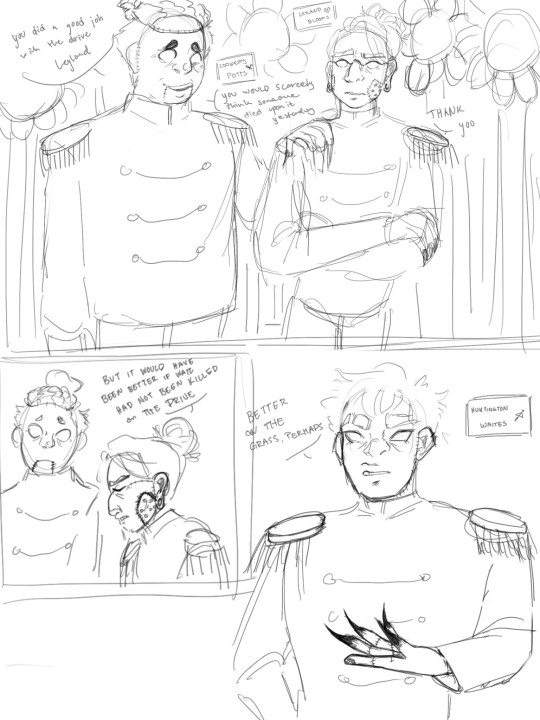
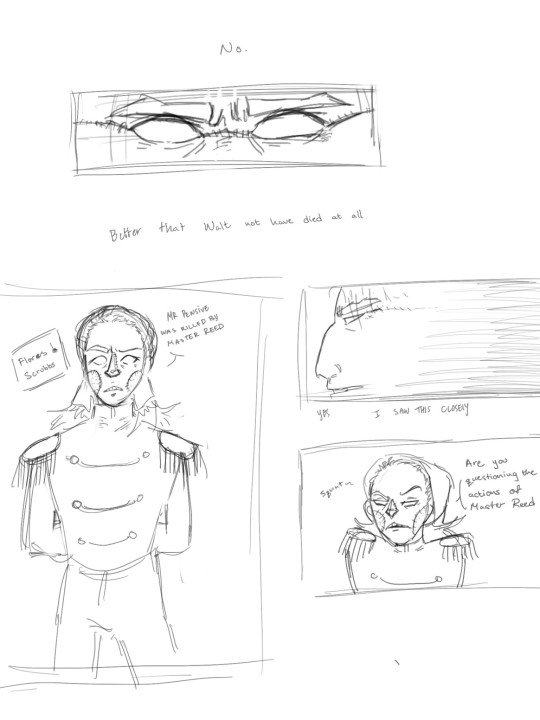
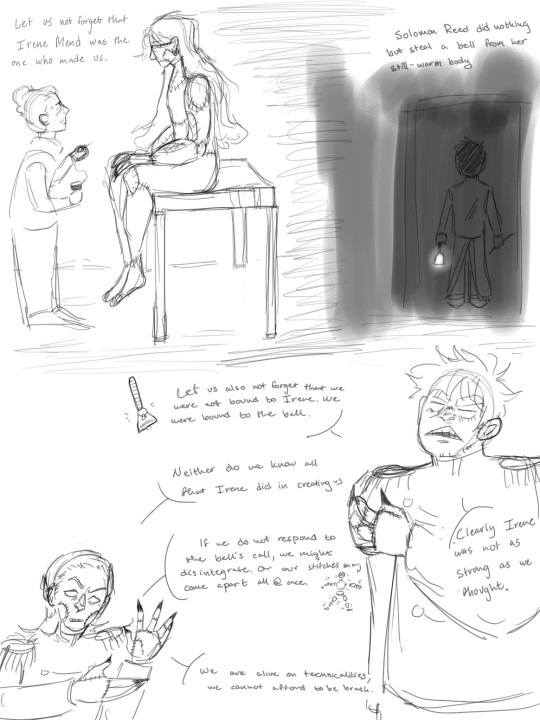

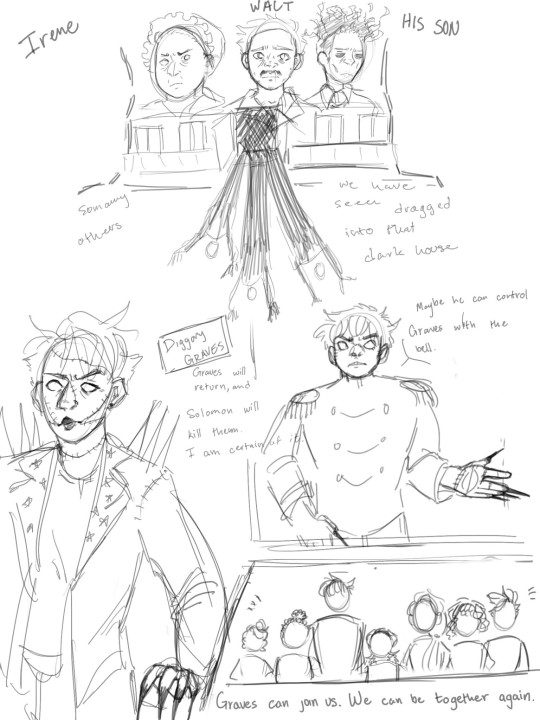
A scene from Episode 40 -Graves- from Hello From the Hallowoods featuring my favorite set of characters :)
I was going to do the whole scene but I ended up not finishing but I decided to still post it. Designs for these characters change a lot for me lol
#hello from the hallowoods#hfth#diggory graves#leyland blooms#cookery potts#Huntington waites#floris scrubbs#Townsend Rhodes#Stitchery Pins#percy reed#irene mend#walter pensive#The mendies#with the addition of Diggory Scrubbs is officially the middle child
53 notes
·
View notes
Text
*Excluding Diggory because we all know they'd sweep
#hfth#hfth polls#it feels mean to tag diggory in a poll they aren't in but. I'm doing it anyway#diggory graves#leyland blooms#stitchery pins#cookery potts#huntington waites#tattery stabs#floris scrubbs#townsend rhodes#kind of expecting either Leyland or tattery to win but I'm not sure#also if you see this and aren't a hfth fan- 1. get of tumblr and go listen#and 2. pick based on vibes
13 notes
·
View notes
Text
Francesca Woodman - Angel series, 1977-1978

"In this photograph the artist has dressed herself in large crumpled sheets of paper, creating a ghostly form. This is one of a series of similar works by Woodman produced between 1977 and 1978 exploring the theme of angels, in which prolonged exposure is used to create a spectral blur. Taken in a deserted factory in Rome, Woodman uses abandoned debris to create an ethereal, mystical image in the tradition of Surrealism. The mythological theme of the angel is popular with Woodman and suggests a link with American fashion photographer Deborah Turbeville (born 1938). In the photograph she uses a mirror as a prop – it becomes a symbol of artistic self-reflexivity, reflecting the ‘eye’ of the camera back upon itself."
"Woodman produced this image from her Angel Series during a year spent abroad in Rome from 1977 to 1978, after gaining a scholarship from the Rhode Island School of Design (RISD). In several other photographs in the Angel Series (reproduced Townsend 2006, pp.152–3, 159), Woodman takes on the form of the ‘angel’ more explicitly, making wings out of white sheets. Art historian Rosalind Krauss has suggested that the works produced during Woodman’s time at RISD were responses to studio assignments posed by university lecturers, with the Angel Series responding to a brief ‘to photograph something that doesn’t exist’ (Krauss 2000, p.162). Following such instructions, Woodman’s preparatory method was meticulous, as she invested time in making sketches of the layout of her photographic compositions before approaching the camera. The most recognisable trait of her practice, as art historian Harriet Riches notes, was the way ‘Woodman used herself to address the technical problems of focus, the creativity of composition or the spaces created through depth of field’ (Riches 2011, p.72). She preferred long, single exposures that simultaneously capture great surface and texture detail, and also allowed the blurring and obscuring of her subjects through movement. Therefore, despite her planning, Woodman ultimately left the final composition to chance. For her Angel Series, looking towards the theme of angelic spectral figures and the transitioning of states, this approach lent itself very well.
In this particular image a recognisable domestic space frames an unsettling staging of figures and objects, just out of reach beyond the doorframe. The viewer is privy to the scene, but excluded from observing the entire interior and its inhabitants. At first glance the rectangular form appears as another doorway, confusing the viewer’s immediate perception of the scene, in which normal objects disrupt the space and conceal the figures with an almost sculptural quality. As art historian Abigail Solomon-Godeau has noted, ‘the relationship constructed [in the photographer’s work] is not between the real woman and her image, but between the spectator and two equally unreal images’ (Abigail Solomon-Godeau, Photography at the Dock, Minneapolis 1991, p.255). Typical of Woodman's work, the still regularity of the board sits in contrast to the messiness of the crumpled paper, heightening the oppositionality of these two points of focus, as seen in Space², Providence, Rhode Island 1976 (Tate AR00350). It is therefore the single hand that becomes the focal point of the image: the dark human shape against the bright white of the rectangular form provides a sense of the uncanny."
0 notes
Text
Hallowoods Favourite Character shown down: Round Two
#hello from the hallowoods polls#hello from the hallowoods#hfth#hfth polls#Riot Maidstone#townsend rhodes
0 notes
Text
Fashion in the 60s


At the dawn of the 1960s, young people’s incomes were at its highest since the end of the Second World War. Increased economic power fuelled a new sense of identity and the need to express it. The fashion industry quickly responded by creating designs for young people that no longer simply copied ‘grown up’ styles. The Beatniks and the Mods (abbreviation of ‘Modernists’) were particularly influential in the early decade.
New shops were introduced such as boutiques, they were small, self-service shops set up in London by designers who wanted to offer affordable fashions to ordinary young people. Designers, such as Mary Quant and John Stephen were the pioneers of this new form of retail. Within just a few years the boutique scene has exploded. These now-iconic shops sold affordable separates suited to a busy, urban lifestyle.
The mini-skirt, which was popularised by Mary Quant, quickly earned its place as the decade’s most iconic look.
The 1960s loved man-made materials. They exploited the potential of modern plastics and synthetic fibres- Perspex, PVC, polyester, acrylic, nylon, rayon, Spandex etc. This was to create easy-care outfits that were eye-catching and fun.
In the late 1960s, style had became theatrical. Fashion sanctioned for longer hair for both men and women, as well as a flared outline for trousers. The ideas and mix-and-match aesthetic of California’s hippy movement crossed the Atlantic, giving people free rein to ‘live different’ and to sport clothing from a range of non-Western cultures. Fashion leaders began to sport long, loose and layered outfits, these were inspired by second-hand or ‘vintage’ styles.
This new direction was reflected in the fashions of :
- Zandra Rhodes
- Foale and Tuffin
- Yves St Laurent
Harvard Referencing
V&A. (N/A) An introduction to 1960s fashion. [Online] Available from: https://www.vam.ac.uk/articles/an-introduction-to-1960s-fashion. [Accessed: 10th December 2022].
Fig 1. FRENCH, J. (1964) Model wearing a Mary Quant dress, 1964, England. [Photograph] Available from: https://www.vam.ac.uk/articles/an-introduction-to-1960s-fashion. [Accessed: 10th December 2022].
Fig 2. TOWNSEND, P. (1960s) Interior of the Biba store, High Street Kensington, 1960s. [Photograph] Available from: https://www.vam.ac.uk/articles/an-introduction-to-1960s-fashion. [Accessed: 11th December 2022].
1 note
·
View note
Text
if anyone watches sweet magnolia, pleaseeee send in asks about cece, ty, kyle, and annie. i wanna have a discussion about themmm
10 notes
·
View notes